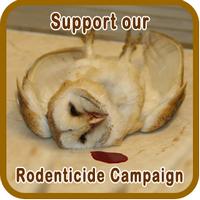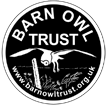 The vast majority of rat poisons used these days (such as Neosorexa and Slaymor) are highly toxic SGARs –‘Second Generation Anticoagulant Rodenticides’.
The vast majority of rat poisons used these days (such as Neosorexa and Slaymor) are highly toxic SGARs –‘Second Generation Anticoagulant Rodenticides’.
Most birds of prey are contaminated
The extent to which SGARs have contaminated small-mammal predators is shocking. The  proportion of Barn Owls contaminated reached its highest level in 2015, an alarming 94%. The latest (2022) figure is virtually 90%. Earlier results from the Predatory Bird Monitoring Scheme show that 100% of the Kestrels they examined in 2011 were contaminated along with 94% of Red Kites! The problem is not restricted to a particular area. The analysed corpses were sent in by the public from across Britain. In other words, virtually the entire populations of these 3 sentinel species have been feeding on rodents that contain rat poison. Sparrowhawks (93%), Buzzards (48%), Peregrine Falcons (35%) and even Hedgehogs (57%) contain SGAR poisons. In fact, research has shown that in a specific year there is a negative correlation between the Kestrel population index and the total SGAR concentration in the same year (Roos et al, 2020) suggesting SGARs are potentially having a population-limiting effect on Kestrels. What other species are potentially being affected? Read about the background to the rat poison problem
proportion of Barn Owls contaminated reached its highest level in 2015, an alarming 94%. The latest (2022) figure is virtually 90%. Earlier results from the Predatory Bird Monitoring Scheme show that 100% of the Kestrels they examined in 2011 were contaminated along with 94% of Red Kites! The problem is not restricted to a particular area. The analysed corpses were sent in by the public from across Britain. In other words, virtually the entire populations of these 3 sentinel species have been feeding on rodents that contain rat poison. Sparrowhawks (93%), Buzzards (48%), Peregrine Falcons (35%) and even Hedgehogs (57%) contain SGAR poisons. In fact, research has shown that in a specific year there is a negative correlation between the Kestrel population index and the total SGAR concentration in the same year (Roos et al, 2020) suggesting SGARs are potentially having a population-limiting effect on Kestrels. What other species are potentially being affected? Read about the background to the rat poison problem
The big question; are sub-lethal doses having any effect?
 As the rodenticide industry is quick to point out, there is no evidence that sub-lethal doses have any effect on Barn Owls. But in fact, there is no evidence that it is not affecting them. Nest cameras such as those used by BBC SpringWatch have revealed marked differences in the behaviour of breeding Barn Owls and it is clear that some are far more energetic than others. We know that safe medicinal doses of the anti-coagulant Warfarin can have side effects in humans including nausea and that the poisons found in Barn Owls are 100 to 1,000 times more acutely toxic than Warfarin. Even if behavioural changes are slight, with 76% of farms using highly toxic rodenticides and 78-94% of Barn Owls contaminated, the overall effect could be dramatic because almost the entire population is affected.
As the rodenticide industry is quick to point out, there is no evidence that sub-lethal doses have any effect on Barn Owls. But in fact, there is no evidence that it is not affecting them. Nest cameras such as those used by BBC SpringWatch have revealed marked differences in the behaviour of breeding Barn Owls and it is clear that some are far more energetic than others. We know that safe medicinal doses of the anti-coagulant Warfarin can have side effects in humans including nausea and that the poisons found in Barn Owls are 100 to 1,000 times more acutely toxic than Warfarin. Even if behavioural changes are slight, with 76% of farms using highly toxic rodenticides and 78-94% of Barn Owls contaminated, the overall effect could be dramatic because almost the entire population is affected.
The problem with rats
![A Brown Rat [Simon Booth] Rat Poison Brown Rat Simon Booth](/wp-content/uploads/rat-poison_brown-rat-simon-booth-250x188.jpg) A great many EU member states are opposed to the use of SGARs and in 2012 the prospect of an EU-wide ban sent a shock wave through the rodenticide and rodent control industries, particularly because there are no new rodent poisons on the horizon. Rats are clearly a threat to human health and their colonisation of some small UK islands, with devastating consequences for ground nesting seabirds, shows that they can do real damage to some of our native wildlife too. It is an inescapable fact that rats need to be controlled. How to control rats as safely as possible.
A great many EU member states are opposed to the use of SGARs and in 2012 the prospect of an EU-wide ban sent a shock wave through the rodenticide and rodent control industries, particularly because there are no new rodent poisons on the horizon. Rats are clearly a threat to human health and their colonisation of some small UK islands, with devastating consequences for ground nesting seabirds, shows that they can do real damage to some of our native wildlife too. It is an inescapable fact that rats need to be controlled. How to control rats as safely as possible.
Resistance to SGARs is an increasing problem
‘Resistance’ means that rats in some areas are no longer affected by some poisons; they are feeding on SGARs and surviving. In the worst-affected area (South Midlands down to Berkshire) Local Authorities and other Pest Control Operators have been seeking special permission from HSE (Health and Safety Executive) to use the strongest SGARs (those only licenced for indoor use) to control rats in open areas accessed by the public. So far, none of these applications has been granted and Authorities have been unable to discharge their responsibilities for protecting public health.
Poisoning is set to continue
Despite the fact that poisoning is not the best way to deal with most infestations, the use of poisons is set to continue. Indeed the EU has now allowed member states to continue licensing the use of SGARs for periods of up to 5 years provided that certain criteria are met including the minimisation of environmental risks through mitigation measures.
To date, mitigation measures such as use-restriction regulations and statutory safety notices on SGAR products have failed to prevent increases in wildlife contamination, or increases in resistance to SGARs in some parts of the UK.
HSE review of SGAR authorisation in the UK
Against a background of EU pressure, widespread wildlife contamination, and rising resistance to SGARs amongst rats, in 2012 HSE launched a major review of the regulations covering the sale, use, and labelling of SGARs which provided a fantastic opportunity for our campaign. The Barn Owl Trust’s contribution to the Review was:
- Hard-hitting presentation at the HSE SGAR Seminar: in 2013 we applied pressure during the HSE’s Stakeholder Engagement process and subsequently attended HSE’s SGAR Seminar in Merseyside where our Head of Conservation gave a hard-hitting presentation to representatives of rodenticide manufacturers, pest controllers and government regulators. Read a PDF of the Barn Owl Trust SGAR seminar presentation.
- Published Article: we were subsequently invited by Jonathan Peck, Chairman of the Killgerm Group and member of the National Pest Advisory Panel of the Chartered Institute of Environmental Health, to submit an article for publication in Pest Control News. Read the Barn Owl Trust article in Pest Control News.
- Delivered a petition containing over 126,000 signatures to the Minister responsible for pesticides in 2014. See the detail of our petition.
- Providing detailed comments and recommendations to HSE in response to the draft SGAR Stewardship Regime Proposals and CRRU Code of Best Practice prepared by the rodenticide industry.
- Responded in 2016 to the EU consultation on alternatives to rodenticides making a strong case for the use of Environmental Management as a substitute for highly toxic poisons. This means substantially reducing rat numbers by preventing or reducing their access to food and harbourage.
 Read the Barn Owl Trust submission to the EU European Chemicals Agency.
Read the Barn Owl Trust submission to the EU European Chemicals Agency.
UK Rodenticide Stewardship Scheme
Following the review, a Stewardship Scheme was implemented in the period April 2016-17. Under the scheme, professional use quantities (over 1kg) can only be sold to users (farmers, gamekeepers, professional pest controllers etc.) who can demonstrate that they have attended an approved Training Course. It is hoped that training and the use of improved paperwork, such as Environmental Impact Assessments and Best Practice Guides, will result in a significant reduction in the unwanted poisoning of non-target species. The scheme is being led by CRRU (Campaign for Responsible Rodenticide Use), a group set up by rodenticide manufacturing companies. The effectiveness of the scheme is being monitored mainly through the levels of rodenticide detected in the livers of dead Barn Owls sent in by the public to the PBMS (Predatory Bird Monitoring Scheme). Before the introduction of Stewardship, based on a seven-year baseline, 81% of Barn Owls contained one or more SGARs. Results from the first year of monitoring following the implementation of Stewardship (2017) showed no reduction in the exposure of Barn Owls, with 90% of carcasses containing one or more Second Generation Anticoagulants. The latest figure (from 2022) is 88%. Clearly, the training of rodenticide users has so far proved ineffective.
In 2021, an update to the Scheme’s Code of Best Practice was initiated to tackle what the CRRU termed “stubbornly static” rodenticide residues in Barn Owls. Previously only guidance, it is now only legal for professional users (pest controllers, farmers and gamekeepers) to use non-standard ‘scenarios’ such as permanent and burrow baiting, and covered bait stations if specifically permitted to do so on the product label. The update also includes new information on cholecalciferol and hydrogen cyanide, two active substances returning to the UK market.
The 7-year failure of Stewardship to reduce the unwanted poisoning of Barn Owls has prompted CRRU (the Campaign for Responsible Rodenticide Use UK) and the UK biocides regulator (the Health and Safety Executive (HSE)) to ban the use of SGARs away from buildings. Sales of Second Generation Anticoagulant Rodenticide products containing bromadiolone and difenacoum for use in open areas and at waste dumps will cease on 4 July 2024. In other words, from that date, in the UK, it will be illegal to use any SGAR product to treat a rodent infestation not associated with a building. Given the propensity of Barn Owls to hunt in and around buildings, it is entirely possible that this move will also fail to reduce their contamination.
Other relevant pages:
- Report a dead owl
- Background to the rat poison problem – how the poisons work, routes of wildlife contamination etc.
- How to control rats as safely as possible – a list of control options in order of preference.
- Rat poison product list – buyer’s guide to product names and active ingredients divided into 1st and 2nd generation (SGARs).
There’s more information on this topic in the Barn Owl Conservation Handbook.
